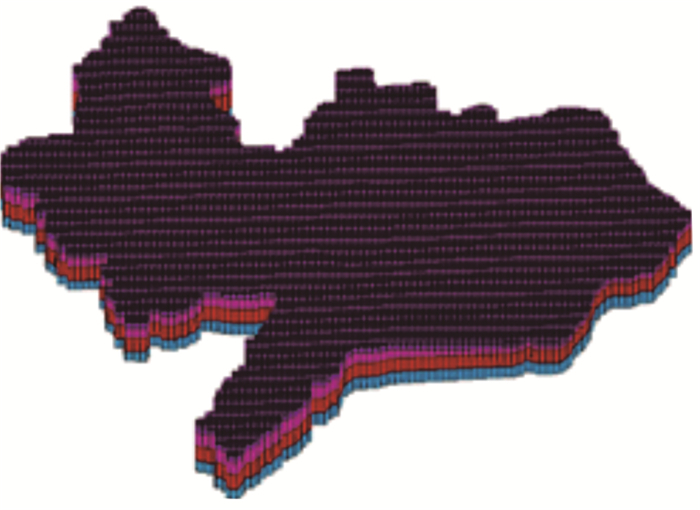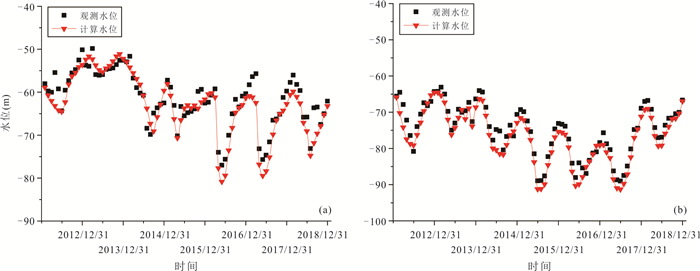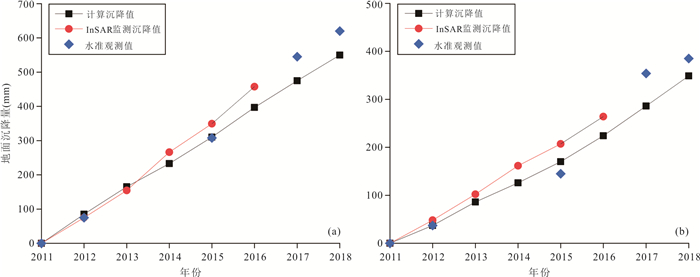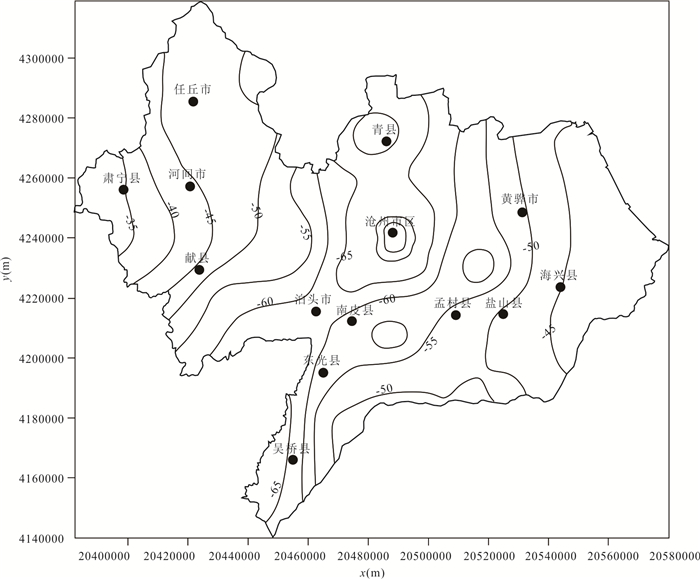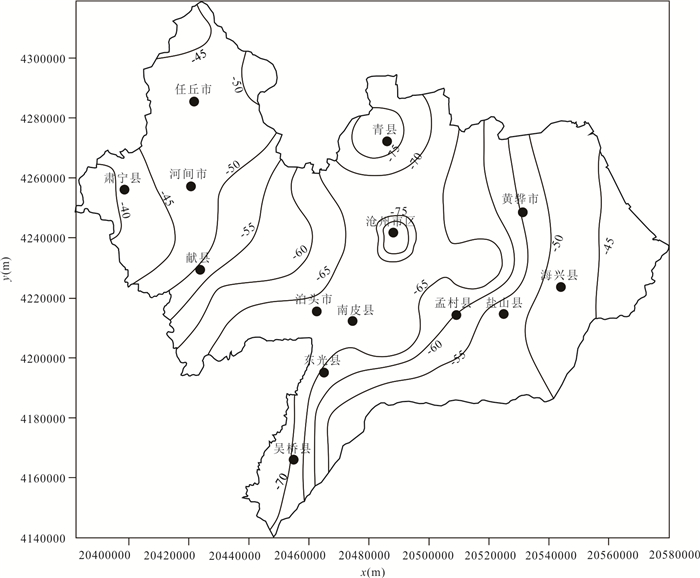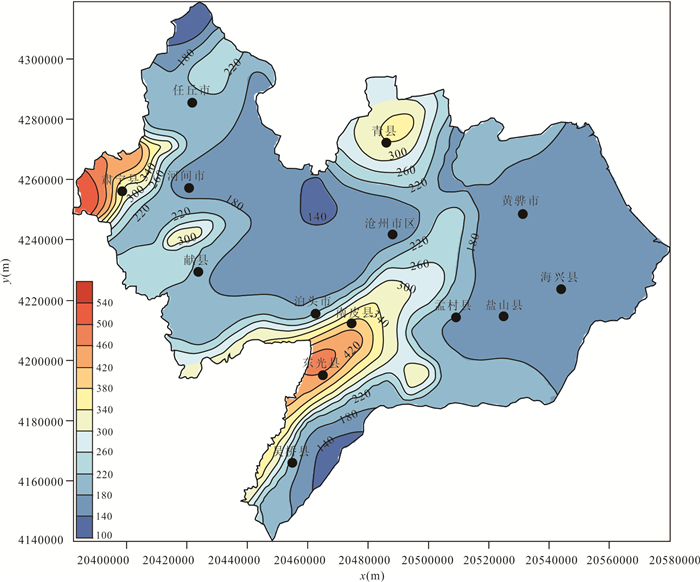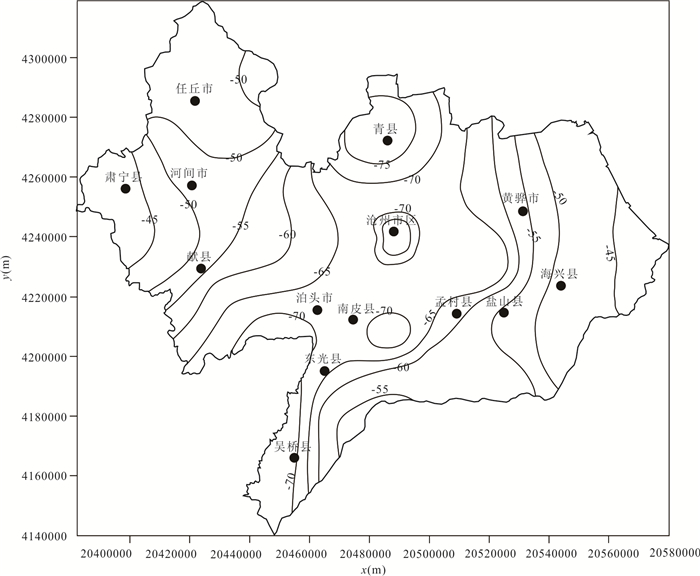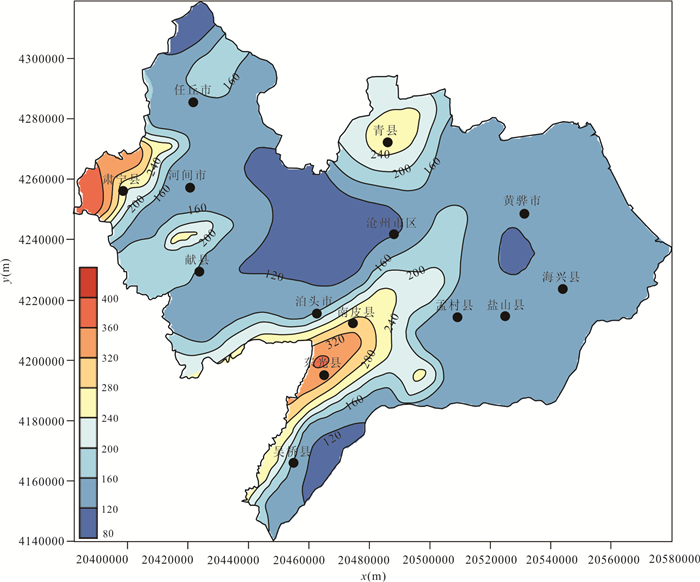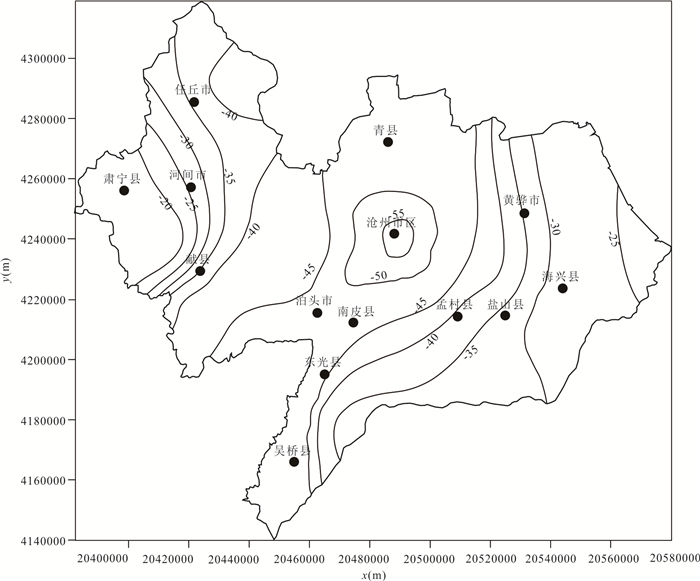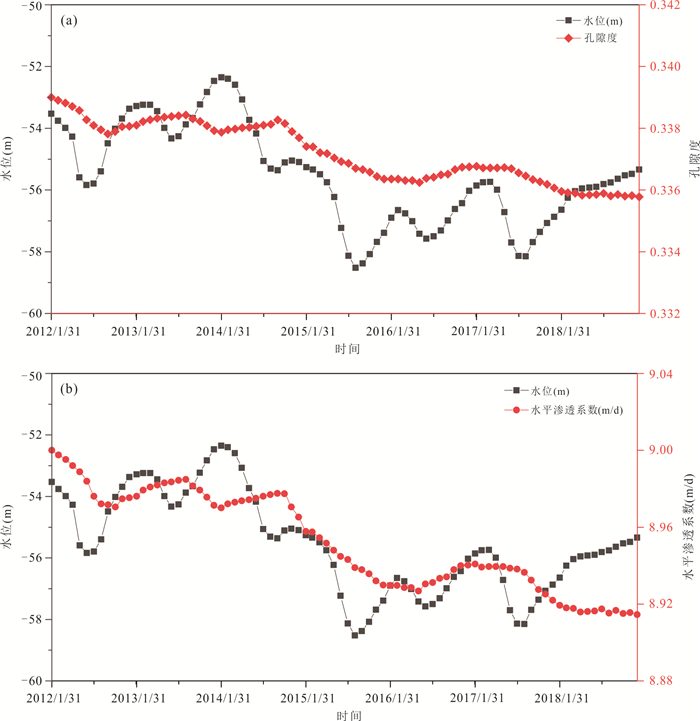Influence of Land Subsidence on Minable Groundwater Resources
-
摘要: 为研究地面沉降对地下水可采资源量的影响,以华北地区沧州市为例,基于Biot固结理论,建立了地下水开采与地面沉降三维变参全耦合黏弹塑性数值模型.分别预测了2019-2030年按现状开采地下水,2031-2040年禁采(方案一);2019-2030年规划开采,2031-2040年禁采(方案二);和2019-2040年地下水持续禁采(方案三)三方案的地面沉降量和各个方案在2041-2050年的地下水可采资源量.结果表明,2041-2050年,方案一、方案二和方案三的地下水可采资源量分别为1.29×108 m3/a、1.35× 108 m3/a和1.43×108 m3/a.方案二比方案一的累计地面沉降减少84.4 mm,地下水可采资源量多6×106 m3/a;相较于方案一,方案三发生了88 mm的地面回弹,地下水可采资源量多1.4×107 m3/a.说明了地面沉降严重的情况下,地下水可采资源量相对较少.Abstract: In order to study the impact of land subsidence on minable groundwater resources, taking Cangzhou City in North China as an example, based on Biot consolidation theory, a three-dimensional variable-parameter fully coupled viscoelastic-plastic numerical model of groundwater exploitation and land subsidence is established. Regarding groundwater mining from 2019 to 2030 based on current conditions and a ban on mining from 2031 to 2040 (scheme 1), compression mining from 2019 to 2030 and a ban on mining from 2031 to 2040 (scheme 2), and continuous ban on groundwater mining from 2019 to 2040 (scheme 3), the land subsidence of each scheme is predicted, and the minable groundwater resources of each scheme from 2041 to 2050 are reasonably evaluated. Results show: from 2041 to 2050, the minable groundwater resources of scheme 1, scheme 2 and scheme 3 are 1.29×108 m3/a, 1.35×108 m3/a and 1.43×108 m3/a, respectively. Compared with scheme 1, the maximum cumulative land subsidence of scheme 2 is reduced by 84.4 mm, and its minable groundwater resources increase by 6×106 m3/a. Compared with scheme 1, scheme 3 achieves a ground rebound of 88 mm, and its minable groundwater resources increase by 1.4×107 m3/a. These fully explain that the amount of recoverable groundwater resources is relatively small under the condition of severe land subsidence.
-
表 1 第Ⅲ含水层组各参数分区的参数汇总
Table 1. Parameters for each parameter zone of the Ⅲ aquifer
分区 主轴渗透系数(m/D) 变形模量(MPa) 泊松比 黏聚力(kPa) 摩擦角(°) 重度(kN/m3) Kx Ky Kz E ν c φ γ 21 10 10 0.025 0 23.85 0.45 6.3 23 20.73 22 10 10 0.001 5 23.83 0.45 6.0 20 20.63 23 8.4 8.4 0.001 8 24.65 0.44 6.5 20 20.69 24 8.5 8.5 0.095 0 23.63 0.45 7.0 19 20.76 25 8.5 8.5 0.003 0 23.55 0.46 7.5 20 20.93 26 7.5 7.5 0.000 4 23.47 0.46 6.0 19 20.75 27 9.5 9.5 0.000 1 24.45 0.46 6.5 21 20.69 28 5 5 0.004 8 23.5 0.46 6.0 17 20.70 29 5 5 0.010 9 23.52 0.46 6.0 19 20.75 30 6 6 0.001 4 23.52 0.46 6.2 19 20.85 31 3 3 0.001 5 25.15 0.47 6.0 18 20.75 32 5 5 0.000 3 23.23 0.47 6.0 19 21.13 33 4 4 0.000 7 24.03 0.47 7.0 17 21.03 34 8 8 0.007 0 23.35 0.47 6.5 19 21.23 表 2 2019-2040年累计沉降量及2041-2050年地下水可采资源量
Table 2. Summary of subsidence from 2019 to 2040 and groundwater resources from 2041 to 2050
县市 开采井个数 方案一 方案二 方案三 沉降量(mm) 可采资源量(104m3/a) 沉降量(mm) 可采资源量(104m3/a) 沉降量(mm) 可采资源量(104m3/a) 肃宁县 6 716 559.38 875.07 475.00 915.76 ‒88.15 972.46 泊头市 7 474 382.04 1 212.78 321.81 1 269.17 ‒61.06 1 347.76 沧县 7 390 164.93 1 099.12 139.17 1 150.22 ‒27.89 1 221.45 东光县 6 767 536.43 561.81 473.05 587.93 ‒84.65 624.34 海兴县 2 516 187.86 88.87 156.06 93.00 ‒31.39 98.76 河间市 7 474 353.29 1 079.99 308.25 1 130.20 ‒56.67 1 200.18 孟村县 8 027 181.41 205.97 153.19 215.54 ‒30.41 228.89 南皮县 6 775 464.53 1 160.50 402.80 1 214.46 ‒73.66 1 289.66 青县 9 144 391.95 827.73 309.21 866.22 ‒62.58 919.86 任丘市 741 263.52 1 978.60 204.69 2 070.59 ‒42.95 2 198.80 吴桥县 9 254 395.34 595.08 344.08 622.75 ‒63.09 661.31 献县 7 390 358.11 1 606.88 313.65 1 681.59 ‒57.40 1 785.72 盐山县 352 203.89 684.25 172.26 716.06 ‒33.84 760.40 黄骅市 952 199.24 616.41 168.35 645.07 ‒33.13 685.01 总计 89 997 12 869.24 13 467.58 14 301.52 -
Biot, M. A., 1941. General Theory of Three-Dimensional Consolidation. Journal of Applied Physics, 12(2): 155-164. https://doi.org/10.1063/1.1712886 Chen, C. X., Pei, S. P., 2001. Research on Groundwater Exploitation-Land Subsidence Model. Hydrogeology and Engineering Geology, 28(2): 5-8 (in Chinese with English abstract). doi: 10.3969/j.issn.1000-3665.2001.02.002 Chen, F., Ding, Y. Y., Li, Y. Y., et al., 2020. Practice and Consideration of Groundwater Overexploitation in North China Plain. South-to-North Water Transfers and Water Science & Technology, 18(2): 191-198 (in Chinese with English abstract). Di, S. T., Jia, C., Zhang, S. P., et al., 2020. Regional Characteristics and Evolutionary Trend Prediction of Land Subsidence Caused by Groundwater over Exploitation in North Shandong of the North China Plain. Acta Geologica Sinica, 94(5): 1638-1654 (in Chinese with English abstract). doi: 10.3969/j.issn.0001-5717.2020.05.020 Fu, Y. L., 2012. Plan and Evaluation of Groundwater Exploitable Resources on the Basis of Land Subsidence Control in the Regional Loose Sediment Area. Journal of Jilin University (Earth Science Edition), 42(2): 476-484 (in Chinese with English abstract). Fu, Y. L., Luo, Z. J., Jin, W. Z., et al., 2017. Impact of High-Rise Building Load on Land Subsidence in Nantong. Journal of Jiangsu University (Natural Science Edition), 38(3): 336-342, 360 (in Chinese with English abstract). Guo, H. P., Li, W. P., Wang, L. Y., et al., 2021. Present Situation and Research Prospects of the Land Subsidence Driven by Groundwater Levels in the North China Plain. Hydrogeology & Engineering Geology, 48(3): 162-171 (in Chinese with English abstract). Jia, C., Zhang, G. R., Wang, J. B., et al., 2015. Study on Land Subsidence Induced by Groundwater Extraction and Its Engineering Application: Taking Dezhou Area of Shandong as an Example. Journal of Earth Sciences and Environment, 37(4): 102-110 (in Chinese with English abstract). Li, Y. J., Wang, X. D., Wang, Y. P., et al., 2018. Deformation Characteristics of Sand in Confined Aquifer under Cyclic Pumping-Recharging Groundwater. Chinese Journal of Geotechnical Engineering, 40(10): 1943-1949 (in Chinese with English abstract). doi: 10.11779/CJGE201810023 Liu, Y., 2013. Temporal and Spatial Evolution Characteristics and Mechanism of Land Subsidence in the Yellow River Delta Region (Dissertation). Institute of Oceanology, Chinese Academy of Sciences, Qingdao (in Chinese with English abstract). Liu, Y., Li, P. Y., Feng, A. P., et al., 2014. Sulfur and Oxygen Isotope Compositions of Dissolved Sulfate in the Yangtze River during High Water Period and Its Sulfate Source Tracing. Earth Science, 39(11): 1655-1665 (in Chinese with English abstract). Luo, Y., Yan, X. X., Yang, T. L., et al., 2019. Space-Time Characteristics of Exploitation and Recharge of Groundwater and Land Subsidence of Shanghai's Land Area. Journal of Nanjing University (Natural Science), 55(3): 449-457 (in Chinese with English abstract). Luo, Z. J., Ning, D., Du, J. J., et al., 2019. Influence of Building Load and Groundwater Exploitation on Land Subsidence in Shengze, Wujiang. Journal of Jilin University (Earth Science Edition), 49(2): 514-525 (in Chinese with English abstract). Luo, Z. J., Zhang, X., Tian, X. W., 2018. Prediction and Early Warning of Cangzhou Land Subsidence Disaster. Journal of Engineering Geology, 26(2): 365-373 (in Chinese with English abstract). Lü, L. P., 2012. Distribution Characteristics and Evolution Mechanism of Groundwater Fluorine in Cangzhou Area (Dissertation). Liaoning Technical University, Fuxin (in Chinese with English abstract). Mao, L., Zhang, Y., Liu, M. Y., et al., 2019. Evaluation of Groundwater Recoverable Resources under the Constraints of Land Subsidence in Jiangsu Coastal Areas. Journal of Nanjing University (Natural Science), 55(3): 429-439 (in Chinese with English abstract). Ning, D., Luo, Z. J., Ge, W. Y., et al., 2019. Analysis on the Influence of Building Load and Groundwater Exploitation on Land Subsidence in Southern Jiangyin, Jiangsu. Geological Review, 65(6): 1549-1558 (in Chinese with English abstract). Shen, S. L., Xu, Y. S., 2011. Numerical Evaluation of Land Subsidence Induced by Groundwater Pumping in Shanghai. Canadian Geotechnical Journal, 48(9): 1378-1392. https://doi.org/10.1139/t11-049 Sun, R. L., He, S. W., Huang, K., 2021. Study on the Influencing Factors of Specific Yield of Unconfined Aquifer Using Laboratory Column Drainage Experiment. Earth Science, 46(5): 1840-1847 (in Chinese with English abstract). Wang, F., Miao, L. C., 2011. Study of Long-Term Deformation Characteristics of Sand Aquifers for Land Subsidence Caused by Groundwater Withdrawal. Chinese Journal of Rock Mechanics and Engineering, 30(S1): 3135-3140 (in Chinese with English abstract). Wang, J. F., Yuan, W., He, K., et al., 2020. Influence of Stress History on Consolidation Coefficient of Saturated Soft Soil. Earth Science, 45(12): 4640-4648 (in Chinese with English abstract). Yin, Z. Z., Zhou, J., Zhao, Z. H., et al., 2006. Constitutive Relations and Deformation Calculation for Unsaturated Soils. Chinese Journal of Geotechnical Engineering, 28(2): 137-146 (in Chinese with English abstract). Yu, H. R., Gong, H. L., Chen, B. B., et al., 2020. The Advance and Consideration of Land Subsidence in Beijing-Tianjin-Hebei Region. Science of Surveying and Mapping, 45(4): 125-133, 141 (in Chinese with English abstract). Zhang, Y., Xue, Y. Q., Shi, X. Q., et al., 2005. Study on Nonlinear Creep Model for Saturated Sand. Rock and Soil Mechanics, 26(12): 1869-1873 (in Chinese with English abstract). doi: 10.3969/j.issn.1000-7598.2005.12.001 Zhang, Y. P., Tang, Y. Q., Xu, J., et al., 2017. Deformation Law and Settlement Mechanism of Silt Caused by Cyclic Rise-Fall of Water Table. Journal of Tongji University (Natural Science), 45(12): 1773-1782 (in Chinese with English abstract). 陈崇希, 裴顺平, 2001. 地下水开采‒地面沉降模型研究. 水文地质工程地质, 28(2): 5-8. 陈飞, 丁跃元, 李原园, 等, 2020. 华北地区地下水超采治理实践与思考. 南水北调与水利科技(中英文), 18(2): 191-198. 狄胜同, 贾超, 张少鹏, 等, 2020. 华北平原鲁北地区地下水超采导致地面沉降区域特征及演化趋势预测. 地质学报, 94(5): 1638-1654. 付延玲, 2012. 基于地面沉降控制的区域性松散沉积层地下水可采资源规划评价. 吉林大学学报(地球科学版), 42(2): 476-484. 付延玲, 骆祖江, 金玮泽, 等, 2017. 南通市高层建筑荷载对地面沉降的影响. 江苏大学学报(自然科学版), 38(3): 336-342, 360. 郭海朋, 李文鹏, 王丽亚, 等, 2021. 华北平原地下水位驱动下的地面沉降现状与研究展望. 水文地质工程地质, 48(3): 162-171. 贾超, 张国荣, 王嘉斌, 等, 2015. 地下水开采诱发地面沉降研究及其工程应用: 以山东德州地区为例. 地球科学与环境学报, 37(4): 102-110. 李亚杰, 王旭东, 王雅平, 等, 2018. 循环抽注水作用下承压含水层砂土的变形特性. 岩土工程学报, 40(10): 1943-1949. 刘勇, 2013. 黄河三角洲地区地面沉降时空演化特征及机理研究(博士学位论文). 青岛: 中国科学院研究生院(海洋研究所). 刘勇, 李培英, 丰爱平, 等, 2014. 黄河三角洲地下水动态变化及其与地面沉降的关系. 地球科学, 39(11): 1655-1665. doi: 10.3799/dqkx.2014.148 罗跃, 严学新, 杨天亮, 等, 2019. 上海陆域地区地下水采灌与地面沉降的时空特征. 南京大学学报(自然科学), 55(3): 449-457. 骆祖江, 宁迪, 杜菁菁, 等, 2019. 吴江盛泽地区建筑荷载和地下水开采对地面沉降的影响. 吉林大学学报(地球科学版), 49(2): 514-525. 骆祖江, 张鑫, 田小伟, 2018. 沧州市地面沉降灾害预测预警. 工程地质学报, 26(2): 365-373. 吕丽萍, 2012. 沧州地区地下水氟的分布特征及其演变机制(硕士学位论文). 阜新: 辽宁工程技术大学. 毛磊, 张岩, 刘明遥, 等, 2019. 江苏沿海地区地面沉降约束下的地下水可采资源量评价. 南京大学学报(自然科学), 55(3): 429-439. 宁迪, 骆祖江, 葛伟亚, 等, 2019. 江阴南部地区建筑荷载和地下水开采与地面沉降耦合研究. 地质论评, 65(6): 1549-1558. 孙蓉琳, 何世伟, 黄康, 2021. 基于土柱排水实验探讨潜水含水层给水度的影响因素. 地球科学, 46(5): 1840-1847. doi: 10.3799/dqkx.2020.271 王非, 缪林昌, 2011. 抽水地面沉降中含水层长期变形特性研究. 岩石力学与工程学报, 30(S1): 3135-3140. 王江锋, 袁威, 何况, 等, 2020. 应力历史对饱和软土固结系数的影响. 地球科学, 45(12): 4640-4648. doi: 10.3799/dqkx.2020.184 殷宗泽, 周建, 赵仲辉, 等, 2006. 非饱和土本构关系及变形计算. 岩土工程学报, 28(2): 137-146. 于海若, 宫辉力, 陈蓓蓓, 等, 2020. 京津冀地区地面沉降研究进展与思考. 测绘科学, 45(4): 125-133, 141. 张云, 薛禹群, 施小清, 等, 2005. 饱和砂性土非线性蠕变模型试验研究. 岩土力学, 26(12): 1869-1873. 张英平, 唐益群, 徐杰, 等, 2017. 水位循环升降作用下粉土变形及沉降机理. 同济大学学报(自然科学版), 45(12): 1773-1782. -









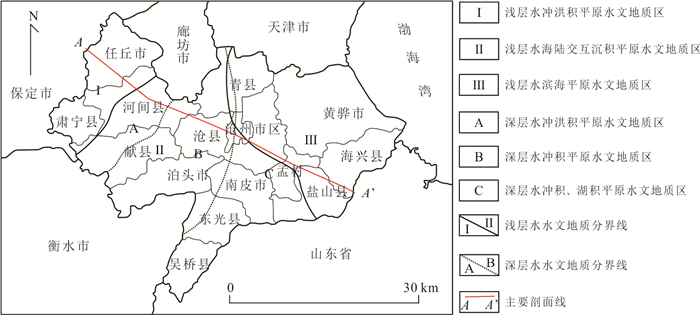
 下载:
下载:

